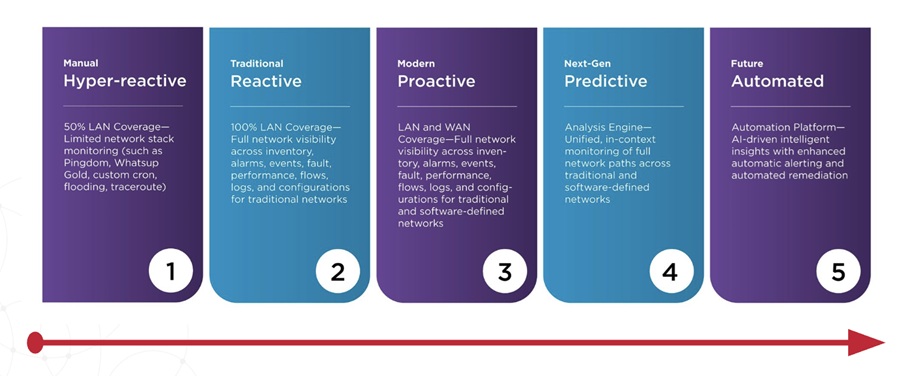Almost all (96%) of business and IT decision-makers in retail agree that AI will have a notable impact on delivering a better digital experience for end users, according to the Riverbed Global AI & Digital Experience Survey
Additionally, 95% of those surveyed at retail organizations say AI is a top C-Suite priority and 84% agree it provides a competitive advantage. In a fast-paced industry where customer service is a priority, the opportunity to use AI to personalize products and services, revolutionize delivery channels, and effectively manage peaks in demand such as Black Friday and Cyber Monday are vast. By leveraging AI to streamline demand forecasting, optimize inventory, personalize customer interactions, and adjust pricing, retailers can have a better handle on these stress points, and deliver a seamless digital experience.

Despite this enthusiasm and the benefits of AI, only 40% of retailers are fully prepared to implement AI projects now, as organizations address challenges ranging from data quality to scalability that are impacting their ability to realize the full benefits of AI. However, rapid expansion is anticipated during the next three years, which is crucial as retailers seek to implement practical AI approaches and solutions that improve the shopping experience. By 2027, 93% of retail leaders expect their organization to be fully prepared to implement their AI strategy and initiatives. This is higher than the overall industry average, in which 86% expect to be fully prepared within three years.
Currently, 54% of business and IT decision makers in retail say the primary reason for using AI is to drive operational efficiencies versus growth (46%). However, during the next three years, when AI is anticipated to mature, those numbers flip, with 56% of organizations saying AI will primarily be a growth driver versus driving efficiencies (44%).
Gen Z and Millennials in Retail Demonstrating AI Expertise
With AI set to transform retail organizations worldwide, the survey found enthusiasm for AI is high among the C-Suite, younger generation employees and organizations as a whole.
■ Today, 71% of retail leaders say AI is a key strategic priority for their organization, and another 29% say it's at least moderately important.
■ There is strong enthusiasm for AI adoption in retail organizations. 64% say AI sentiment in their organization is positive, 33% neutral and only 3% skeptical.
■ Across all sectors, Gen Z are perceived as the standard-bearers for AI, but business and IT decision-makers in the Retail sector perceive Millennials as equally comfortable with the technology. When asked which generation is most comfortable with AI in the workplace, retail leaders said Gen Z (47%) and Millennials (46%), followed by Gen X (6%) and Baby Boomers (1%).
The research also found that most retail organizations have moved past the stages of assessing and experimenting with AI. Today, 65% are accelerating their AI strategies with growing investment in infrastructure and talent; and another 25% are in the final transformative stage where AI is fully integrated into their business processes.
Digital User Experience a Priority for Retail
Riverbed's 2023 survey found that DEX is a critical focus for organizations, especially with heightened digital expectations of Gen Z and Millennial employees, accounting for about half of the global workforce. In this year's survey, enterprises recognized the role AI plays in DEX, as an overwhelming majority of retail organizations, 91%, state that AI automation is important to deliver an improved digital experience for end users. Over half (53%) of retail organizations are achieving improved DEX through 24/7 support (such as chatbots and virtual assistants). By streamlining communications, these tools improve efficiency across organizations, including customer service.
Survey respondents reported the main ways they expect to use AI within IT to improve DEX within 3 years' time included: automated remediation (76%), 24/7 support availability such as chatbots (71%), workflow automation (68%), data-driven insight (64%) and feedback analysis (61%).
Despite AI Benefits, Gaps Exist in Retail Sector
Despite widespread AI enthusiasm, the research identified three major gaps that organizations must overcome to ensure their AI adoption results in benefits and enterprise success. Like other sectors, retailers must overcome these gaps in order to achieve successful AI adoption.
■ Reality Gap. Retail organizations are especially confident about their AI implementation for IT services and digital experience, with 84% claiming to be ahead of their peers, including 35% who say they are significantly ahead. Only 4% say they are slightly behind. This gap between perception and reality indicates many leaders are overconfident about where their IT function is on their AI journey relative to their industry peers.
■ Readiness Gap. As stated earlier, there's a readiness gap as only 40% of retail leaders say their organization is fully prepared to implement AI projects now. Additionally, 77% say with AI still maturing, it's challenging to implement AI that works and scales.
■ Data Gap. Nearly all retail leaders (87%) acknowledge that great data is critical for great AI. However, of those surveyed, 72% are concerned about the effectiveness of their organization's data for AI usage, and only 45% rated their data as excellent for accuracy, with 42% saying their data quality is a barrier to further AI investment.
There are also growing concerns in the sector about data confidentiality and security risks, with 91% concerned that AI will access their organization's proprietary data in the public domain due to their organization using AI. As the Retail sector handles increasingly sensitive consumer data, it's critical for organizations to adhere to stringent data protection regulations, and minimize risks associated with the leakage of customer information.
"As retailers prepare for seasonal flash sales such as Black Friday and Cyber Monday, the adoption of AI technology is revolutionizing the Retail sector, offering personalized recommendations and superior shopping experiences," explains Jim Gargan, CMO, at Riverbed. "However, leveraging AI to analyze consumer buying behavior and trends requires access to great data and our recent study reveals that only 45% of business and IT leaders in retail organizations rate their data as excellent for accuracy."
Driving Successful AI Initiatives in Retail
Enterprises are taking several steps to overcome challenges and drive successful AI strategies that deliver tangible results. To address AI preparedness, 55% of retail sector organizations have formed dedicated AI teams, and 50% observability and/or user experience teams. For this sector, investment in AI talent is becoming a priority, as retailers recruit data scientists, AI specialists, and engineers to maintain a competitive edge in a rapidly evolving landscape.
Retailers are exploring other initiatives to drive successful AI integration. When it comes to data, the vast majority of retail leaders (88%) say using real data, rather than synthetic data, is crucial in AI efforts to improve the digital experience.
Additionally, 86% of respondents agree that observability across all elements of IT is important in an AIOps strategy, and observability to overcome network blind spots — including public cloud (86%), enterprise-owned mobile devices (85%), Zero Trust architectures (83%), and remote work environments (82%) — is either extremely or moderately important.
Methdology: The Riverbed Global AI & Digital Experience Survey polled 1,200 IT, business, and public sector decision-makers, 200 of whom were from the retail industry, across seven countries, all with over $250 million in annual revenue (over $500 million in the US, UK, and France). The survey was conducted by Coleman Parkes Research in June 2024.

